Concept of Management Information Systems (MIS)- Report
VerifiedAdded on 2022/07/29
|13
|3538
|33
AI Summary
I already completed the assignment, I only need someone to help in the grammar and quote I added. Plus, a full review the of the assignment
Contribute Materials
Your contribution can guide someone’s learning journey. Share your
documents today.

MIS
Secure Best Marks with AI Grader
Need help grading? Try our AI Grader for instant feedback on your assignments.
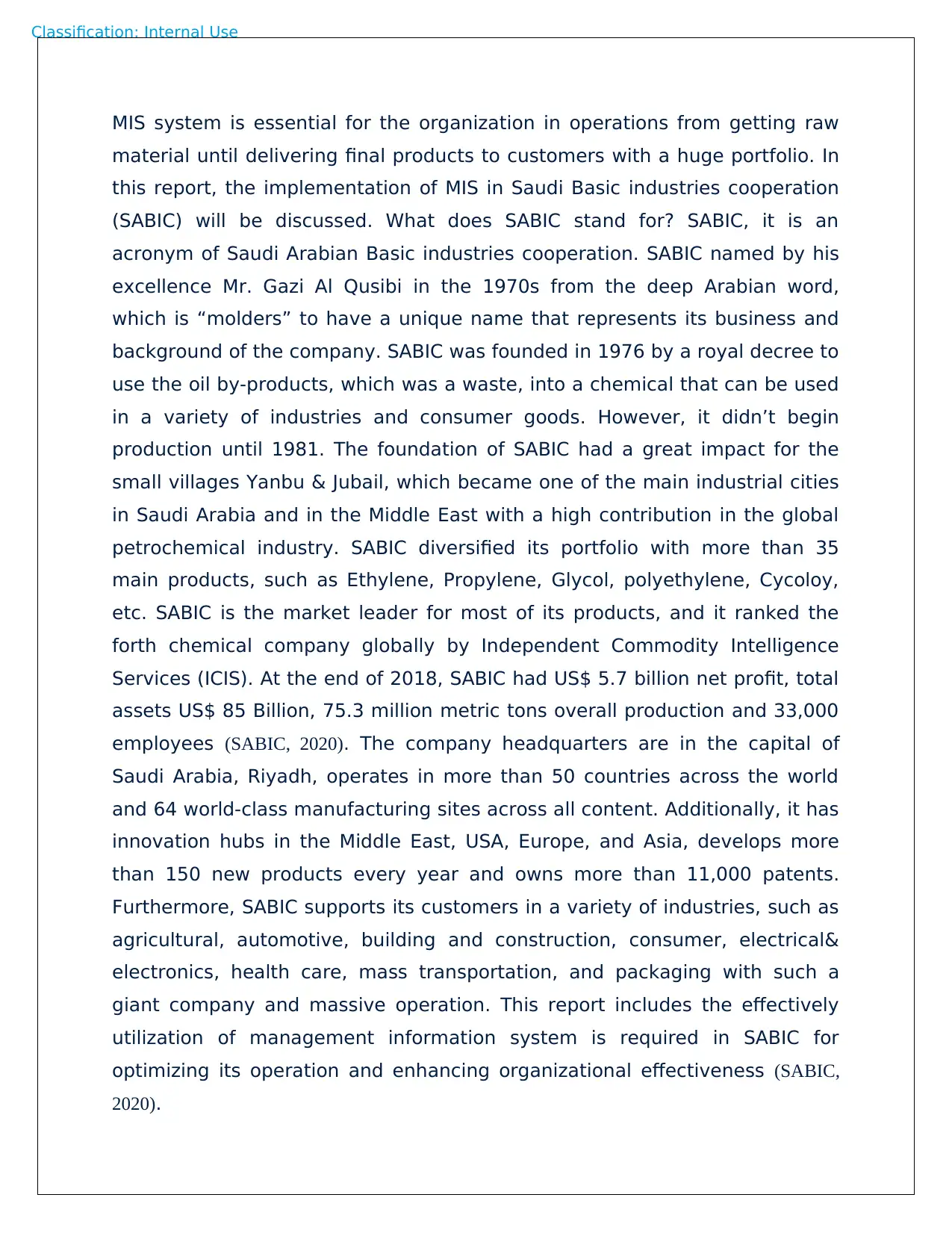
Classification: Internal Use
MIS system is essential for the organization in operations from getting raw
material until delivering final products to customers with a huge portfolio. In
this report, the implementation of MIS in Saudi Basic industries cooperation
(SABIC) will be discussed. What does SABIC stand for? SABIC, it is an
acronym of Saudi Arabian Basic industries cooperation. SABIC named by his
excellence Mr. Gazi Al Qusibi in the 1970s from the deep Arabian word,
which is “molders” to have a unique name that represents its business and
background of the company. SABIC was founded in 1976 by a royal decree to
use the oil by-products, which was a waste, into a chemical that can be used
in a variety of industries and consumer goods. However, it didn’t begin
production until 1981. The foundation of SABIC had a great impact for the
small villages Yanbu & Jubail, which became one of the main industrial cities
in Saudi Arabia and in the Middle East with a high contribution in the global
petrochemical industry. SABIC diversified its portfolio with more than 35
main products, such as Ethylene, Propylene, Glycol, polyethylene, Cycoloy,
etc. SABIC is the market leader for most of its products, and it ranked the
forth chemical company globally by Independent Commodity Intelligence
Services (ICIS). At the end of 2018, SABIC had US$ 5.7 billion net profit, total
assets US$ 85 Billion, 75.3 million metric tons overall production and 33,000
employees (SABIC, 2020). The company headquarters are in the capital of
Saudi Arabia, Riyadh, operates in more than 50 countries across the world
and 64 world-class manufacturing sites across all content. Additionally, it has
innovation hubs in the Middle East, USA, Europe, and Asia, develops more
than 150 new products every year and owns more than 11,000 patents.
Furthermore, SABIC supports its customers in a variety of industries, such as
agricultural, automotive, building and construction, consumer, electrical&
electronics, health care, mass transportation, and packaging with such a
giant company and massive operation. This report includes the effectively
utilization of management information system is required in SABIC for
optimizing its operation and enhancing organizational effectiveness (SABIC,
2020).
MIS system is essential for the organization in operations from getting raw
material until delivering final products to customers with a huge portfolio. In
this report, the implementation of MIS in Saudi Basic industries cooperation
(SABIC) will be discussed. What does SABIC stand for? SABIC, it is an
acronym of Saudi Arabian Basic industries cooperation. SABIC named by his
excellence Mr. Gazi Al Qusibi in the 1970s from the deep Arabian word,
which is “molders” to have a unique name that represents its business and
background of the company. SABIC was founded in 1976 by a royal decree to
use the oil by-products, which was a waste, into a chemical that can be used
in a variety of industries and consumer goods. However, it didn’t begin
production until 1981. The foundation of SABIC had a great impact for the
small villages Yanbu & Jubail, which became one of the main industrial cities
in Saudi Arabia and in the Middle East with a high contribution in the global
petrochemical industry. SABIC diversified its portfolio with more than 35
main products, such as Ethylene, Propylene, Glycol, polyethylene, Cycoloy,
etc. SABIC is the market leader for most of its products, and it ranked the
forth chemical company globally by Independent Commodity Intelligence
Services (ICIS). At the end of 2018, SABIC had US$ 5.7 billion net profit, total
assets US$ 85 Billion, 75.3 million metric tons overall production and 33,000
employees (SABIC, 2020). The company headquarters are in the capital of
Saudi Arabia, Riyadh, operates in more than 50 countries across the world
and 64 world-class manufacturing sites across all content. Additionally, it has
innovation hubs in the Middle East, USA, Europe, and Asia, develops more
than 150 new products every year and owns more than 11,000 patents.
Furthermore, SABIC supports its customers in a variety of industries, such as
agricultural, automotive, building and construction, consumer, electrical&
electronics, health care, mass transportation, and packaging with such a
giant company and massive operation. This report includes the effectively
utilization of management information system is required in SABIC for
optimizing its operation and enhancing organizational effectiveness (SABIC,
2020).
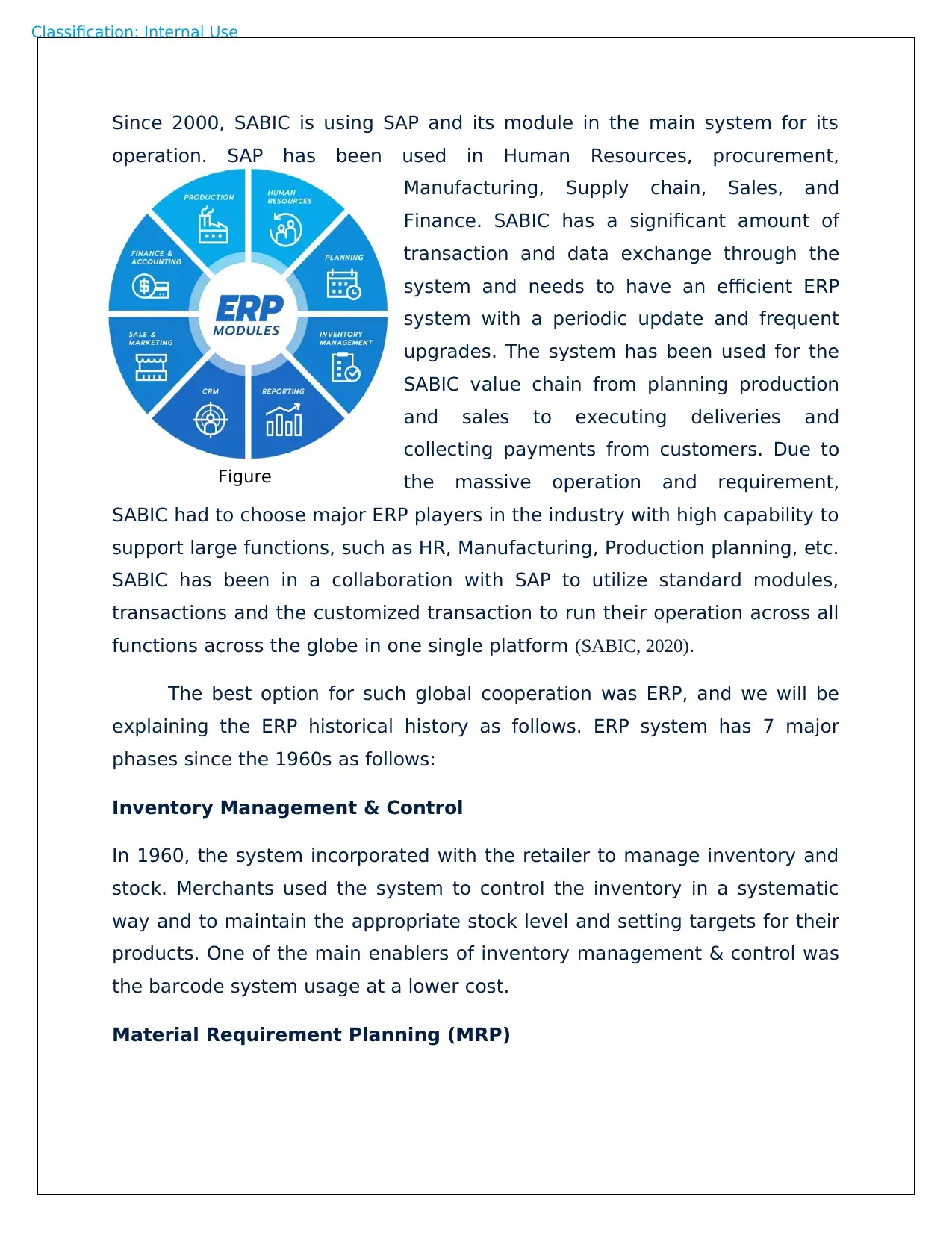
Classification: Internal Use
Since 2000, SABIC is using SAP and its module in the main system for its
operation. SAP has been used in Human Resources, procurement,
Manufacturing, Supply chain, Sales, and
Finance. SABIC has a significant amount of
transaction and data exchange through the
system and needs to have an efficient ERP
system with a periodic update and frequent
upgrades. The system has been used for the
SABIC value chain from planning production
and sales to executing deliveries and
collecting payments from customers. Due to
the massive operation and requirement,
SABIC had to choose major ERP players in the industry with high capability to
support large functions, such as HR, Manufacturing, Production planning, etc.
SABIC has been in a collaboration with SAP to utilize standard modules,
transactions and the customized transaction to run their operation across all
functions across the globe in one single platform (SABIC, 2020).
The best option for such global cooperation was ERP, and we will be
explaining the ERP historical history as follows. ERP system has 7 major
phases since the 1960s as follows:
Inventory Management & Control
In 1960, the system incorporated with the retailer to manage inventory and
stock. Merchants used the system to control the inventory in a systematic
way and to maintain the appropriate stock level and setting targets for their
products. One of the main enablers of inventory management & control was
the barcode system usage at a lower cost.
Material Requirement Planning (MRP)
Figure
Since 2000, SABIC is using SAP and its module in the main system for its
operation. SAP has been used in Human Resources, procurement,
Manufacturing, Supply chain, Sales, and
Finance. SABIC has a significant amount of
transaction and data exchange through the
system and needs to have an efficient ERP
system with a periodic update and frequent
upgrades. The system has been used for the
SABIC value chain from planning production
and sales to executing deliveries and
collecting payments from customers. Due to
the massive operation and requirement,
SABIC had to choose major ERP players in the industry with high capability to
support large functions, such as HR, Manufacturing, Production planning, etc.
SABIC has been in a collaboration with SAP to utilize standard modules,
transactions and the customized transaction to run their operation across all
functions across the globe in one single platform (SABIC, 2020).
The best option for such global cooperation was ERP, and we will be
explaining the ERP historical history as follows. ERP system has 7 major
phases since the 1960s as follows:
Inventory Management & Control
In 1960, the system incorporated with the retailer to manage inventory and
stock. Merchants used the system to control the inventory in a systematic
way and to maintain the appropriate stock level and setting targets for their
products. One of the main enablers of inventory management & control was
the barcode system usage at a lower cost.
Material Requirement Planning (MRP)
Figure
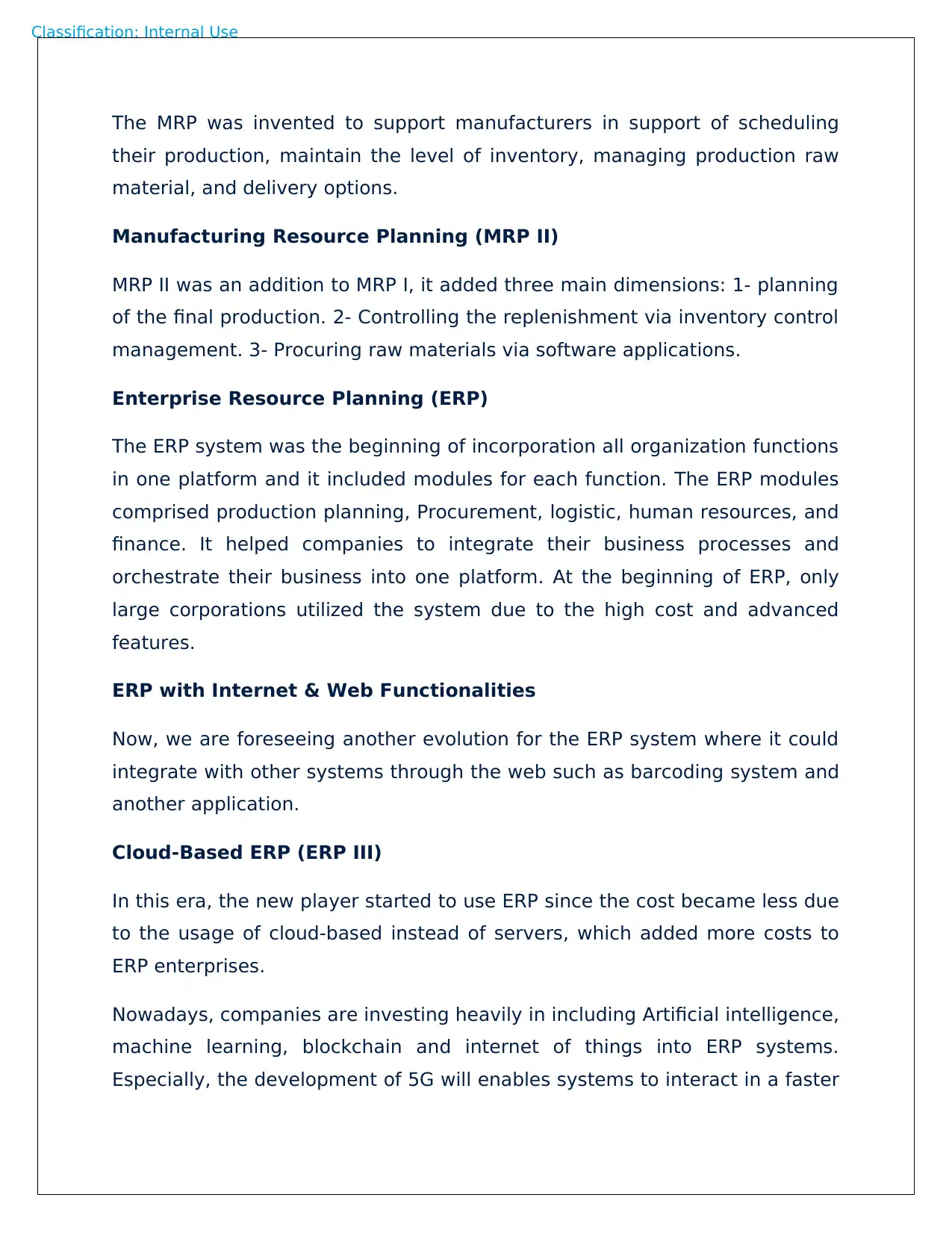
Classification: Internal Use
The MRP was invented to support manufacturers in support of scheduling
their production, maintain the level of inventory, managing production raw
material, and delivery options.
Manufacturing Resource Planning (MRP II)
MRP II was an addition to MRP I, it added three main dimensions: 1- planning
of the final production. 2- Controlling the replenishment via inventory control
management. 3- Procuring raw materials via software applications.
Enterprise Resource Planning (ERP)
The ERP system was the beginning of incorporation all organization functions
in one platform and it included modules for each function. The ERP modules
comprised production planning, Procurement, logistic, human resources, and
finance. It helped companies to integrate their business processes and
orchestrate their business into one platform. At the beginning of ERP, only
large corporations utilized the system due to the high cost and advanced
features.
ERP with Internet & Web Functionalities
Now, we are foreseeing another evolution for the ERP system where it could
integrate with other systems through the web such as barcoding system and
another application.
Cloud-Based ERP (ERP III)
In this era, the new player started to use ERP since the cost became less due
to the usage of cloud-based instead of servers, which added more costs to
ERP enterprises.
Nowadays, companies are investing heavily in including Artificial intelligence,
machine learning, blockchain and internet of things into ERP systems.
Especially, the development of 5G will enables systems to interact in a faster
The MRP was invented to support manufacturers in support of scheduling
their production, maintain the level of inventory, managing production raw
material, and delivery options.
Manufacturing Resource Planning (MRP II)
MRP II was an addition to MRP I, it added three main dimensions: 1- planning
of the final production. 2- Controlling the replenishment via inventory control
management. 3- Procuring raw materials via software applications.
Enterprise Resource Planning (ERP)
The ERP system was the beginning of incorporation all organization functions
in one platform and it included modules for each function. The ERP modules
comprised production planning, Procurement, logistic, human resources, and
finance. It helped companies to integrate their business processes and
orchestrate their business into one platform. At the beginning of ERP, only
large corporations utilized the system due to the high cost and advanced
features.
ERP with Internet & Web Functionalities
Now, we are foreseeing another evolution for the ERP system where it could
integrate with other systems through the web such as barcoding system and
another application.
Cloud-Based ERP (ERP III)
In this era, the new player started to use ERP since the cost became less due
to the usage of cloud-based instead of servers, which added more costs to
ERP enterprises.
Nowadays, companies are investing heavily in including Artificial intelligence,
machine learning, blockchain and internet of things into ERP systems.
Especially, the development of 5G will enables systems to interact in a faster
Secure Best Marks with AI Grader
Need help grading? Try our AI Grader for instant feedback on your assignments.
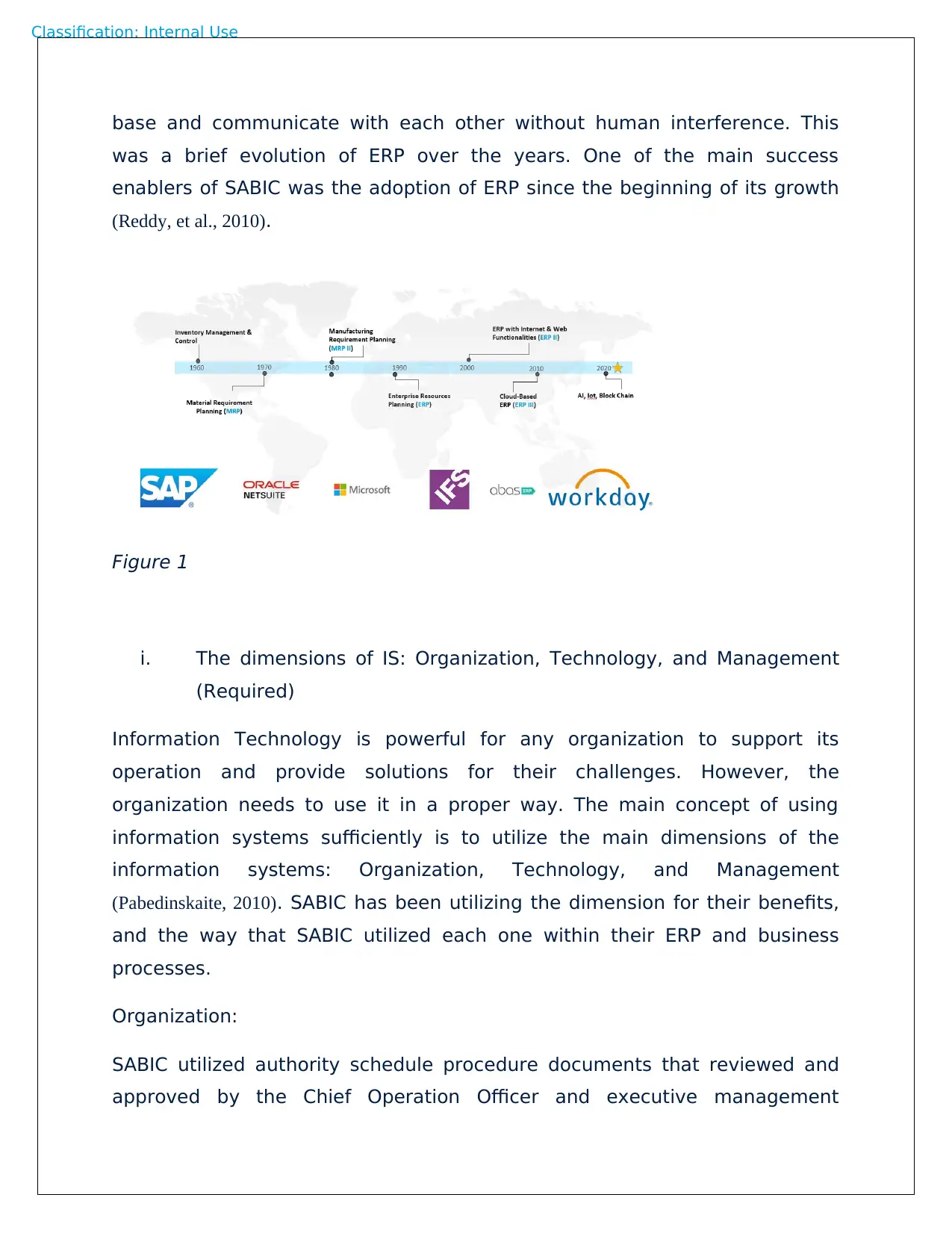
Classification: Internal Use
base and communicate with each other without human interference. This
was a brief evolution of ERP over the years. One of the main success
enablers of SABIC was the adoption of ERP since the beginning of its growth
(Reddy, et al., 2010).
Figure 1
i. The dimensions of IS: Organization, Technology, and Management
(Required)
Information Technology is powerful for any organization to support its
operation and provide solutions for their challenges. However, the
organization needs to use it in a proper way. The main concept of using
information systems sufficiently is to utilize the main dimensions of the
information systems: Organization, Technology, and Management
(Pabedinskaite, 2010). SABIC has been utilizing the dimension for their benefits,
and the way that SABIC utilized each one within their ERP and business
processes.
Organization:
SABIC utilized authority schedule procedure documents that reviewed and
approved by the Chief Operation Officer and executive management
base and communicate with each other without human interference. This
was a brief evolution of ERP over the years. One of the main success
enablers of SABIC was the adoption of ERP since the beginning of its growth
(Reddy, et al., 2010).
Figure 1
i. The dimensions of IS: Organization, Technology, and Management
(Required)
Information Technology is powerful for any organization to support its
operation and provide solutions for their challenges. However, the
organization needs to use it in a proper way. The main concept of using
information systems sufficiently is to utilize the main dimensions of the
information systems: Organization, Technology, and Management
(Pabedinskaite, 2010). SABIC has been utilizing the dimension for their benefits,
and the way that SABIC utilized each one within their ERP and business
processes.
Organization:
SABIC utilized authority schedule procedure documents that reviewed and
approved by the Chief Operation Officer and executive management
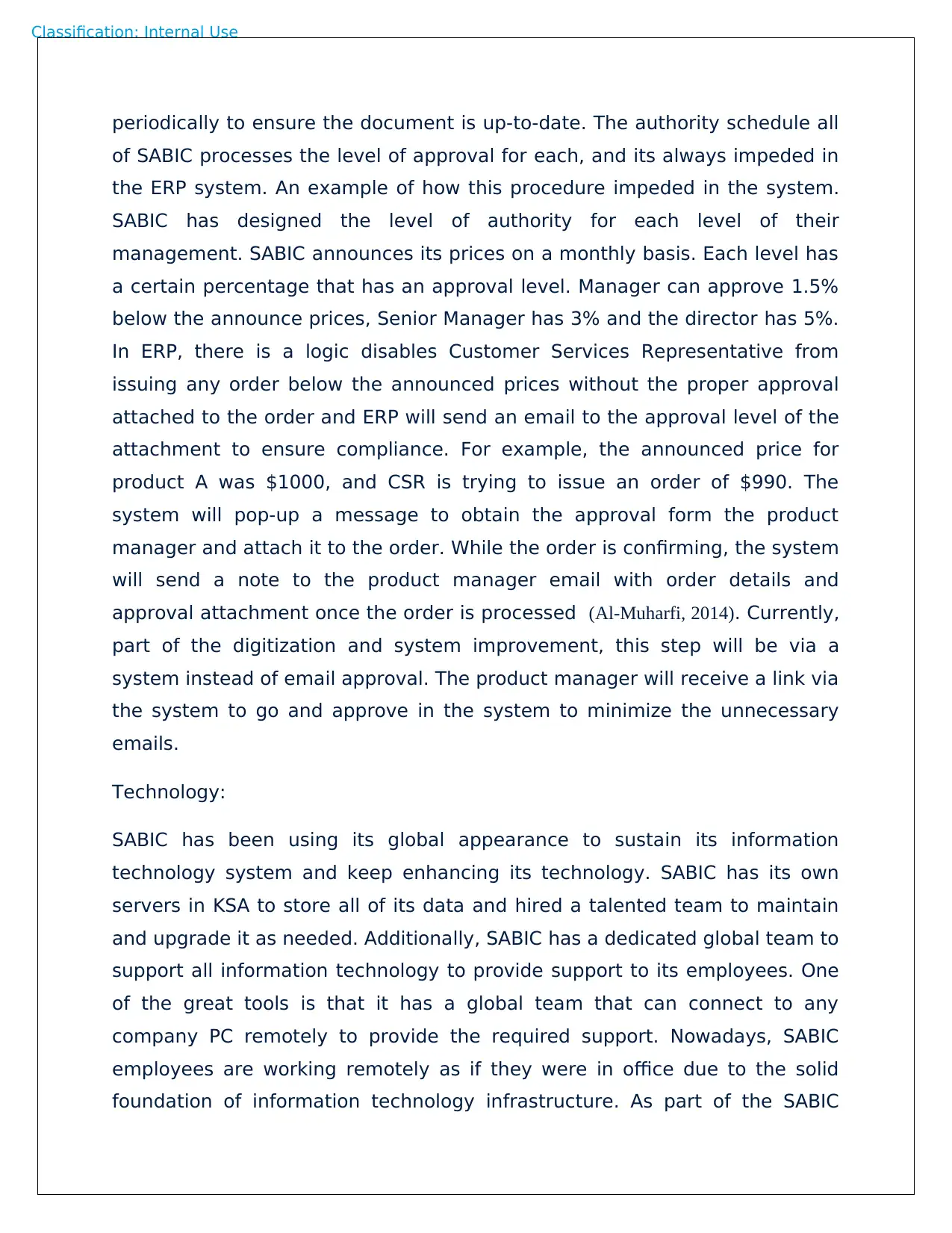
Classification: Internal Use
periodically to ensure the document is up-to-date. The authority schedule all
of SABIC processes the level of approval for each, and its always impeded in
the ERP system. An example of how this procedure impeded in the system.
SABIC has designed the level of authority for each level of their
management. SABIC announces its prices on a monthly basis. Each level has
a certain percentage that has an approval level. Manager can approve 1.5%
below the announce prices, Senior Manager has 3% and the director has 5%.
In ERP, there is a logic disables Customer Services Representative from
issuing any order below the announced prices without the proper approval
attached to the order and ERP will send an email to the approval level of the
attachment to ensure compliance. For example, the announced price for
product A was $1000, and CSR is trying to issue an order of $990. The
system will pop-up a message to obtain the approval form the product
manager and attach it to the order. While the order is confirming, the system
will send a note to the product manager email with order details and
approval attachment once the order is processed (Al-Muharfi, 2014). Currently,
part of the digitization and system improvement, this step will be via a
system instead of email approval. The product manager will receive a link via
the system to go and approve in the system to minimize the unnecessary
emails.
Technology:
SABIC has been using its global appearance to sustain its information
technology system and keep enhancing its technology. SABIC has its own
servers in KSA to store all of its data and hired a talented team to maintain
and upgrade it as needed. Additionally, SABIC has a dedicated global team to
support all information technology to provide support to its employees. One
of the great tools is that it has a global team that can connect to any
company PC remotely to provide the required support. Nowadays, SABIC
employees are working remotely as if they were in office due to the solid
foundation of information technology infrastructure. As part of the SABIC
periodically to ensure the document is up-to-date. The authority schedule all
of SABIC processes the level of approval for each, and its always impeded in
the ERP system. An example of how this procedure impeded in the system.
SABIC has designed the level of authority for each level of their
management. SABIC announces its prices on a monthly basis. Each level has
a certain percentage that has an approval level. Manager can approve 1.5%
below the announce prices, Senior Manager has 3% and the director has 5%.
In ERP, there is a logic disables Customer Services Representative from
issuing any order below the announced prices without the proper approval
attached to the order and ERP will send an email to the approval level of the
attachment to ensure compliance. For example, the announced price for
product A was $1000, and CSR is trying to issue an order of $990. The
system will pop-up a message to obtain the approval form the product
manager and attach it to the order. While the order is confirming, the system
will send a note to the product manager email with order details and
approval attachment once the order is processed (Al-Muharfi, 2014). Currently,
part of the digitization and system improvement, this step will be via a
system instead of email approval. The product manager will receive a link via
the system to go and approve in the system to minimize the unnecessary
emails.
Technology:
SABIC has been using its global appearance to sustain its information
technology system and keep enhancing its technology. SABIC has its own
servers in KSA to store all of its data and hired a talented team to maintain
and upgrade it as needed. Additionally, SABIC has a dedicated global team to
support all information technology to provide support to its employees. One
of the great tools is that it has a global team that can connect to any
company PC remotely to provide the required support. Nowadays, SABIC
employees are working remotely as if they were in office due to the solid
foundation of information technology infrastructure. As part of the SABIC
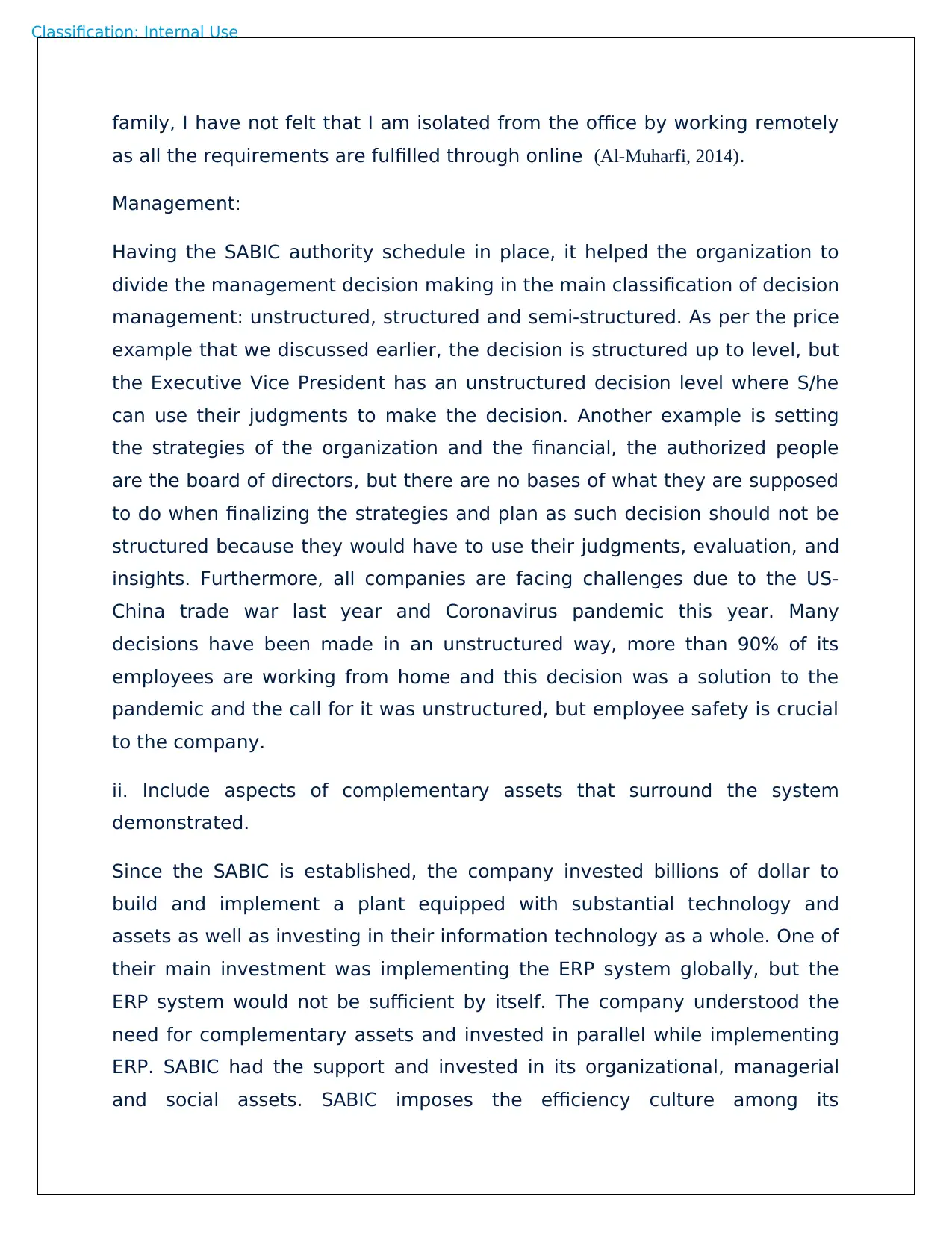
Classification: Internal Use
family, I have not felt that I am isolated from the office by working remotely
as all the requirements are fulfilled through online (Al-Muharfi, 2014).
Management:
Having the SABIC authority schedule in place, it helped the organization to
divide the management decision making in the main classification of decision
management: unstructured, structured and semi-structured. As per the price
example that we discussed earlier, the decision is structured up to level, but
the Executive Vice President has an unstructured decision level where S/he
can use their judgments to make the decision. Another example is setting
the strategies of the organization and the financial, the authorized people
are the board of directors, but there are no bases of what they are supposed
to do when finalizing the strategies and plan as such decision should not be
structured because they would have to use their judgments, evaluation, and
insights. Furthermore, all companies are facing challenges due to the US-
China trade war last year and Coronavirus pandemic this year. Many
decisions have been made in an unstructured way, more than 90% of its
employees are working from home and this decision was a solution to the
pandemic and the call for it was unstructured, but employee safety is crucial
to the company.
ii. Include aspects of complementary assets that surround the system
demonstrated.
Since the SABIC is established, the company invested billions of dollar to
build and implement a plant equipped with substantial technology and
assets as well as investing in their information technology as a whole. One of
their main investment was implementing the ERP system globally, but the
ERP system would not be sufficient by itself. The company understood the
need for complementary assets and invested in parallel while implementing
ERP. SABIC had the support and invested in its organizational, managerial
and social assets. SABIC imposes the efficiency culture among its
family, I have not felt that I am isolated from the office by working remotely
as all the requirements are fulfilled through online (Al-Muharfi, 2014).
Management:
Having the SABIC authority schedule in place, it helped the organization to
divide the management decision making in the main classification of decision
management: unstructured, structured and semi-structured. As per the price
example that we discussed earlier, the decision is structured up to level, but
the Executive Vice President has an unstructured decision level where S/he
can use their judgments to make the decision. Another example is setting
the strategies of the organization and the financial, the authorized people
are the board of directors, but there are no bases of what they are supposed
to do when finalizing the strategies and plan as such decision should not be
structured because they would have to use their judgments, evaluation, and
insights. Furthermore, all companies are facing challenges due to the US-
China trade war last year and Coronavirus pandemic this year. Many
decisions have been made in an unstructured way, more than 90% of its
employees are working from home and this decision was a solution to the
pandemic and the call for it was unstructured, but employee safety is crucial
to the company.
ii. Include aspects of complementary assets that surround the system
demonstrated.
Since the SABIC is established, the company invested billions of dollar to
build and implement a plant equipped with substantial technology and
assets as well as investing in their information technology as a whole. One of
their main investment was implementing the ERP system globally, but the
ERP system would not be sufficient by itself. The company understood the
need for complementary assets and invested in parallel while implementing
ERP. SABIC had the support and invested in its organizational, managerial
and social assets. SABIC imposes the efficiency culture among its
Paraphrase This Document
Need a fresh take? Get an instant paraphrase of this document with our AI Paraphraser
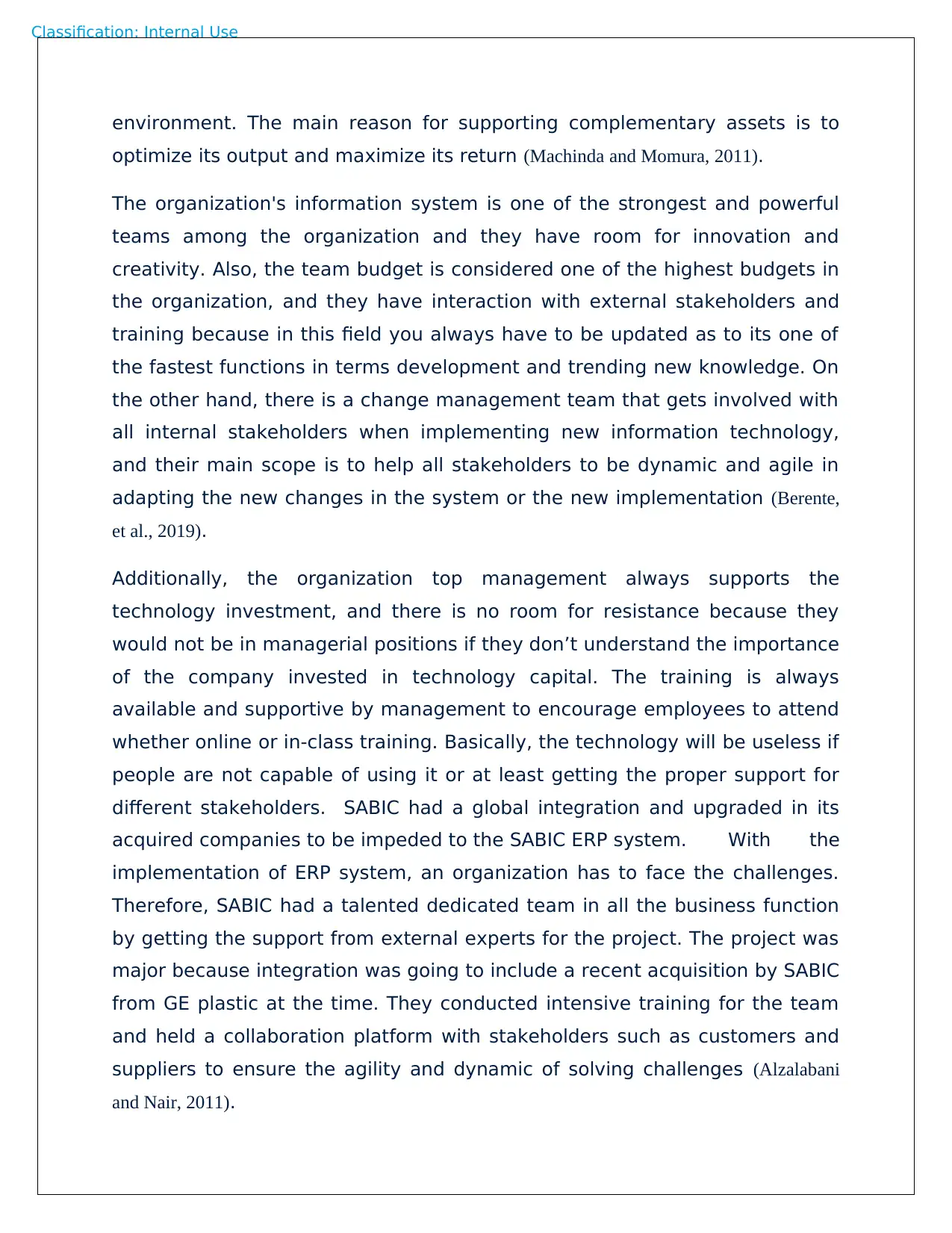
Classification: Internal Use
environment. The main reason for supporting complementary assets is to
optimize its output and maximize its return (Machinda and Momura, 2011).
The organization's information system is one of the strongest and powerful
teams among the organization and they have room for innovation and
creativity. Also, the team budget is considered one of the highest budgets in
the organization, and they have interaction with external stakeholders and
training because in this field you always have to be updated as to its one of
the fastest functions in terms development and trending new knowledge. On
the other hand, there is a change management team that gets involved with
all internal stakeholders when implementing new information technology,
and their main scope is to help all stakeholders to be dynamic and agile in
adapting the new changes in the system or the new implementation (Berente,
et al., 2019).
Additionally, the organization top management always supports the
technology investment, and there is no room for resistance because they
would not be in managerial positions if they don’t understand the importance
of the company invested in technology capital. The training is always
available and supportive by management to encourage employees to attend
whether online or in-class training. Basically, the technology will be useless if
people are not capable of using it or at least getting the proper support for
different stakeholders. SABIC had a global integration and upgraded in its
acquired companies to be impeded to the SABIC ERP system. With the
implementation of ERP system, an organization has to face the challenges.
Therefore, SABIC had a talented dedicated team in all the business function
by getting the support from external experts for the project. The project was
major because integration was going to include a recent acquisition by SABIC
from GE plastic at the time. They conducted intensive training for the team
and held a collaboration platform with stakeholders such as customers and
suppliers to ensure the agility and dynamic of solving challenges (Alzalabani
and Nair, 2011).
environment. The main reason for supporting complementary assets is to
optimize its output and maximize its return (Machinda and Momura, 2011).
The organization's information system is one of the strongest and powerful
teams among the organization and they have room for innovation and
creativity. Also, the team budget is considered one of the highest budgets in
the organization, and they have interaction with external stakeholders and
training because in this field you always have to be updated as to its one of
the fastest functions in terms development and trending new knowledge. On
the other hand, there is a change management team that gets involved with
all internal stakeholders when implementing new information technology,
and their main scope is to help all stakeholders to be dynamic and agile in
adapting the new changes in the system or the new implementation (Berente,
et al., 2019).
Additionally, the organization top management always supports the
technology investment, and there is no room for resistance because they
would not be in managerial positions if they don’t understand the importance
of the company invested in technology capital. The training is always
available and supportive by management to encourage employees to attend
whether online or in-class training. Basically, the technology will be useless if
people are not capable of using it or at least getting the proper support for
different stakeholders. SABIC had a global integration and upgraded in its
acquired companies to be impeded to the SABIC ERP system. With the
implementation of ERP system, an organization has to face the challenges.
Therefore, SABIC had a talented dedicated team in all the business function
by getting the support from external experts for the project. The project was
major because integration was going to include a recent acquisition by SABIC
from GE plastic at the time. They conducted intensive training for the team
and held a collaboration platform with stakeholders such as customers and
suppliers to ensure the agility and dynamic of solving challenges (Alzalabani
and Nair, 2011).
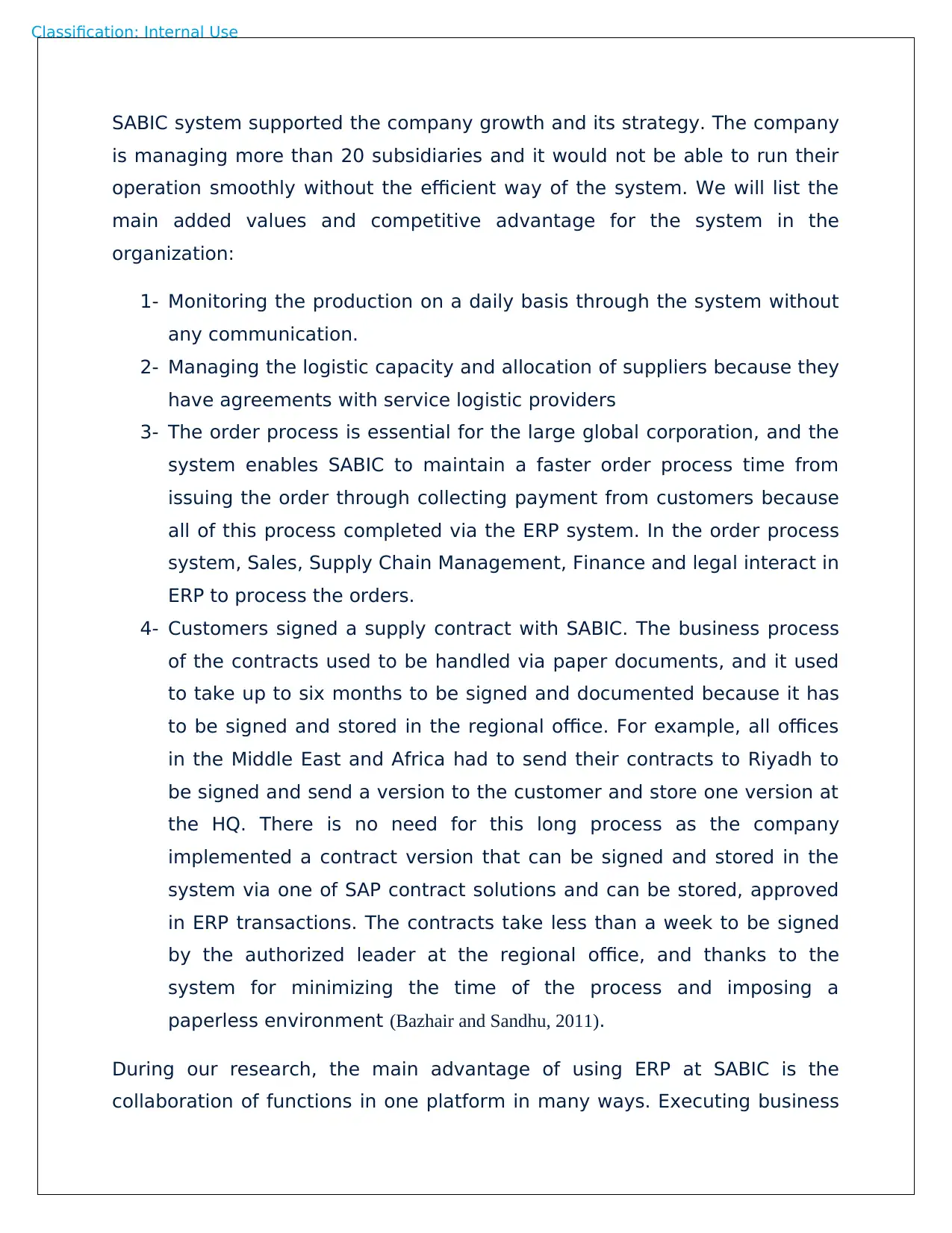
Classification: Internal Use
SABIC system supported the company growth and its strategy. The company
is managing more than 20 subsidiaries and it would not be able to run their
operation smoothly without the efficient way of the system. We will list the
main added values and competitive advantage for the system in the
organization:
1- Monitoring the production on a daily basis through the system without
any communication.
2- Managing the logistic capacity and allocation of suppliers because they
have agreements with service logistic providers
3- The order process is essential for the large global corporation, and the
system enables SABIC to maintain a faster order process time from
issuing the order through collecting payment from customers because
all of this process completed via the ERP system. In the order process
system, Sales, Supply Chain Management, Finance and legal interact in
ERP to process the orders.
4- Customers signed a supply contract with SABIC. The business process
of the contracts used to be handled via paper documents, and it used
to take up to six months to be signed and documented because it has
to be signed and stored in the regional office. For example, all offices
in the Middle East and Africa had to send their contracts to Riyadh to
be signed and send a version to the customer and store one version at
the HQ. There is no need for this long process as the company
implemented a contract version that can be signed and stored in the
system via one of SAP contract solutions and can be stored, approved
in ERP transactions. The contracts take less than a week to be signed
by the authorized leader at the regional office, and thanks to the
system for minimizing the time of the process and imposing a
paperless environment (Bazhair and Sandhu, 2011).
During our research, the main advantage of using ERP at SABIC is the
collaboration of functions in one platform in many ways. Executing business
SABIC system supported the company growth and its strategy. The company
is managing more than 20 subsidiaries and it would not be able to run their
operation smoothly without the efficient way of the system. We will list the
main added values and competitive advantage for the system in the
organization:
1- Monitoring the production on a daily basis through the system without
any communication.
2- Managing the logistic capacity and allocation of suppliers because they
have agreements with service logistic providers
3- The order process is essential for the large global corporation, and the
system enables SABIC to maintain a faster order process time from
issuing the order through collecting payment from customers because
all of this process completed via the ERP system. In the order process
system, Sales, Supply Chain Management, Finance and legal interact in
ERP to process the orders.
4- Customers signed a supply contract with SABIC. The business process
of the contracts used to be handled via paper documents, and it used
to take up to six months to be signed and documented because it has
to be signed and stored in the regional office. For example, all offices
in the Middle East and Africa had to send their contracts to Riyadh to
be signed and send a version to the customer and store one version at
the HQ. There is no need for this long process as the company
implemented a contract version that can be signed and stored in the
system via one of SAP contract solutions and can be stored, approved
in ERP transactions. The contracts take less than a week to be signed
by the authorized leader at the regional office, and thanks to the
system for minimizing the time of the process and imposing a
paperless environment (Bazhair and Sandhu, 2011).
During our research, the main advantage of using ERP at SABIC is the
collaboration of functions in one platform in many ways. Executing business
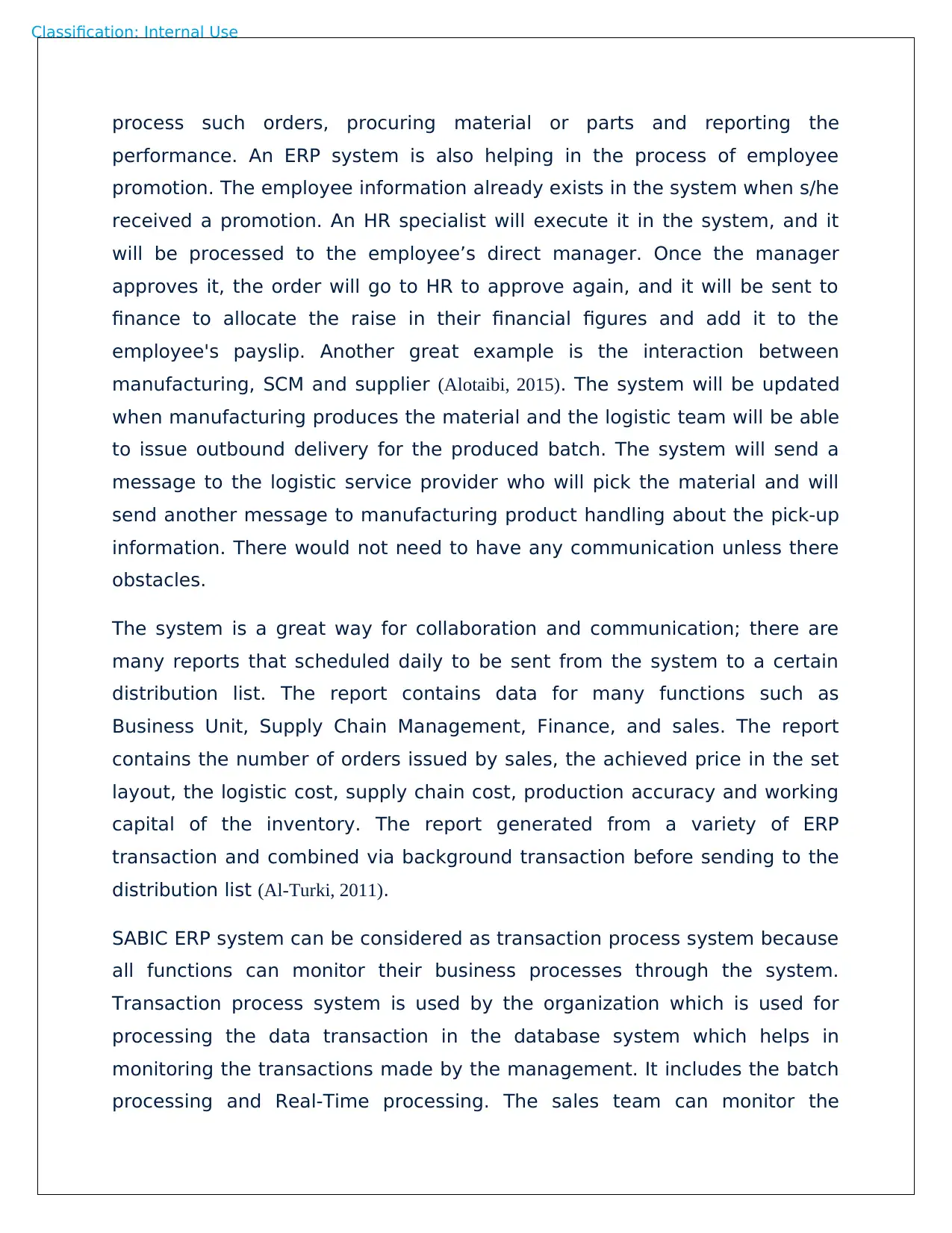
Classification: Internal Use
process such orders, procuring material or parts and reporting the
performance. An ERP system is also helping in the process of employee
promotion. The employee information already exists in the system when s/he
received a promotion. An HR specialist will execute it in the system, and it
will be processed to the employee’s direct manager. Once the manager
approves it, the order will go to HR to approve again, and it will be sent to
finance to allocate the raise in their financial figures and add it to the
employee's payslip. Another great example is the interaction between
manufacturing, SCM and supplier (Alotaibi, 2015). The system will be updated
when manufacturing produces the material and the logistic team will be able
to issue outbound delivery for the produced batch. The system will send a
message to the logistic service provider who will pick the material and will
send another message to manufacturing product handling about the pick-up
information. There would not need to have any communication unless there
obstacles.
The system is a great way for collaboration and communication; there are
many reports that scheduled daily to be sent from the system to a certain
distribution list. The report contains data for many functions such as
Business Unit, Supply Chain Management, Finance, and sales. The report
contains the number of orders issued by sales, the achieved price in the set
layout, the logistic cost, supply chain cost, production accuracy and working
capital of the inventory. The report generated from a variety of ERP
transaction and combined via background transaction before sending to the
distribution list (Al-Turki, 2011).
SABIC ERP system can be considered as transaction process system because
all functions can monitor their business processes through the system.
Transaction process system is used by the organization which is used for
processing the data transaction in the database system which helps in
monitoring the transactions made by the management. It includes the batch
processing and Real-Time processing. The sales team can monitor the
process such orders, procuring material or parts and reporting the
performance. An ERP system is also helping in the process of employee
promotion. The employee information already exists in the system when s/he
received a promotion. An HR specialist will execute it in the system, and it
will be processed to the employee’s direct manager. Once the manager
approves it, the order will go to HR to approve again, and it will be sent to
finance to allocate the raise in their financial figures and add it to the
employee's payslip. Another great example is the interaction between
manufacturing, SCM and supplier (Alotaibi, 2015). The system will be updated
when manufacturing produces the material and the logistic team will be able
to issue outbound delivery for the produced batch. The system will send a
message to the logistic service provider who will pick the material and will
send another message to manufacturing product handling about the pick-up
information. There would not need to have any communication unless there
obstacles.
The system is a great way for collaboration and communication; there are
many reports that scheduled daily to be sent from the system to a certain
distribution list. The report contains data for many functions such as
Business Unit, Supply Chain Management, Finance, and sales. The report
contains the number of orders issued by sales, the achieved price in the set
layout, the logistic cost, supply chain cost, production accuracy and working
capital of the inventory. The report generated from a variety of ERP
transaction and combined via background transaction before sending to the
distribution list (Al-Turki, 2011).
SABIC ERP system can be considered as transaction process system because
all functions can monitor their business processes through the system.
Transaction process system is used by the organization which is used for
processing the data transaction in the database system which helps in
monitoring the transactions made by the management. It includes the batch
processing and Real-Time processing. The sales team can monitor the
Secure Best Marks with AI Grader
Need help grading? Try our AI Grader for instant feedback on your assignments.
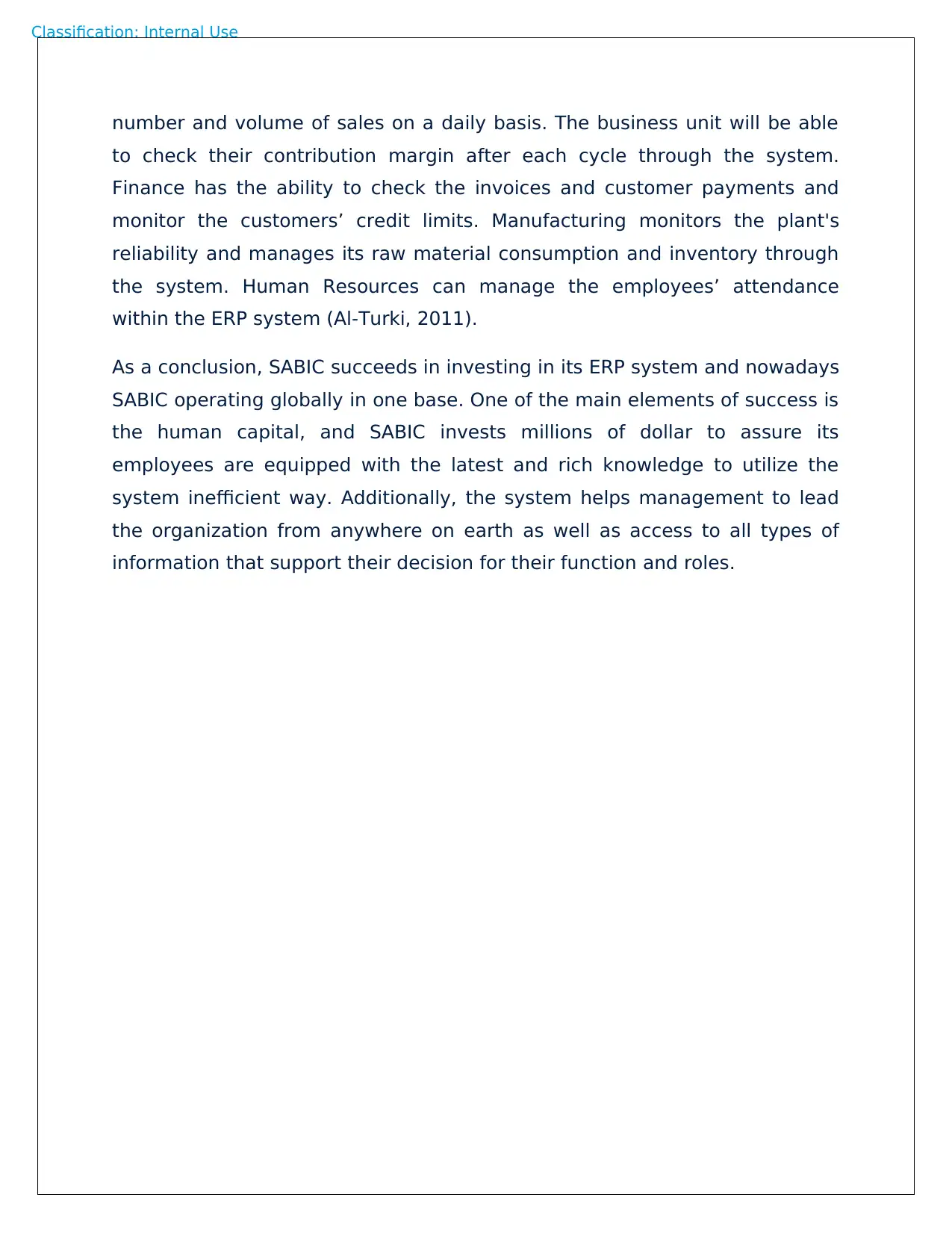
Classification: Internal Use
number and volume of sales on a daily basis. The business unit will be able
to check their contribution margin after each cycle through the system.
Finance has the ability to check the invoices and customer payments and
monitor the customers’ credit limits. Manufacturing monitors the plant's
reliability and manages its raw material consumption and inventory through
the system. Human Resources can manage the employees’ attendance
within the ERP system (Al-Turki, 2011).
As a conclusion, SABIC succeeds in investing in its ERP system and nowadays
SABIC operating globally in one base. One of the main elements of success is
the human capital, and SABIC invests millions of dollar to assure its
employees are equipped with the latest and rich knowledge to utilize the
system inefficient way. Additionally, the system helps management to lead
the organization from anywhere on earth as well as access to all types of
information that support their decision for their function and roles.
number and volume of sales on a daily basis. The business unit will be able
to check their contribution margin after each cycle through the system.
Finance has the ability to check the invoices and customer payments and
monitor the customers’ credit limits. Manufacturing monitors the plant's
reliability and manages its raw material consumption and inventory through
the system. Human Resources can manage the employees’ attendance
within the ERP system (Al-Turki, 2011).
As a conclusion, SABIC succeeds in investing in its ERP system and nowadays
SABIC operating globally in one base. One of the main elements of success is
the human capital, and SABIC invests millions of dollar to assure its
employees are equipped with the latest and rich knowledge to utilize the
system inefficient way. Additionally, the system helps management to lead
the organization from anywhere on earth as well as access to all types of
information that support their decision for their function and roles.
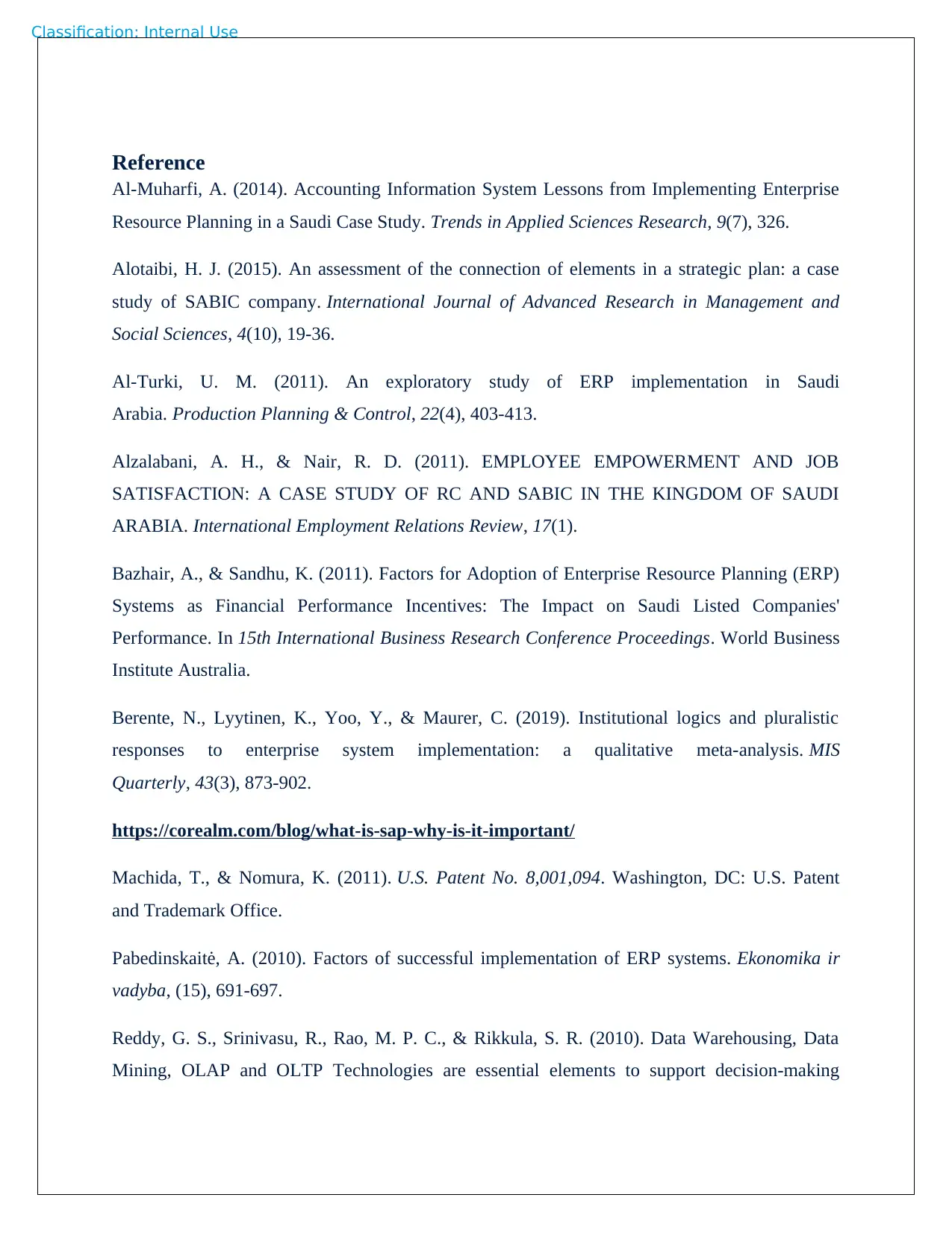
Classification: Internal Use
Reference
Al-Muharfi, A. (2014). Accounting Information System Lessons from Implementing Enterprise
Resource Planning in a Saudi Case Study. Trends in Applied Sciences Research, 9(7), 326.
Alotaibi, H. J. (2015). An assessment of the connection of elements in a strategic plan: a case
study of SABIC company. International Journal of Advanced Research in Management and
Social Sciences, 4(10), 19-36.
Al-Turki, U. M. (2011). An exploratory study of ERP implementation in Saudi
Arabia. Production Planning & Control, 22(4), 403-413.
Alzalabani, A. H., & Nair, R. D. (2011). EMPLOYEE EMPOWERMENT AND JOB
SATISFACTION: A CASE STUDY OF RC AND SABIC IN THE KINGDOM OF SAUDI
ARABIA. International Employment Relations Review, 17(1).
Bazhair, A., & Sandhu, K. (2011). Factors for Adoption of Enterprise Resource Planning (ERP)
Systems as Financial Performance Incentives: The Impact on Saudi Listed Companies'
Performance. In 15th International Business Research Conference Proceedings. World Business
Institute Australia.
Berente, N., Lyytinen, K., Yoo, Y., & Maurer, C. (2019). Institutional logics and pluralistic
responses to enterprise system implementation: a qualitative meta-analysis. MIS
Quarterly, 43(3), 873-902.
https://corealm.com/blog/what-is-sap-why-is-it-important/
Machida, T., & Nomura, K. (2011). U.S. Patent No. 8,001,094. Washington, DC: U.S. Patent
and Trademark Office.
Pabedinskaitė, A. (2010). Factors of successful implementation of ERP systems. Ekonomika ir
vadyba, (15), 691-697.
Reddy, G. S., Srinivasu, R., Rao, M. P. C., & Rikkula, S. R. (2010). Data Warehousing, Data
Mining, OLAP and OLTP Technologies are essential elements to support decision-making
Reference
Al-Muharfi, A. (2014). Accounting Information System Lessons from Implementing Enterprise
Resource Planning in a Saudi Case Study. Trends in Applied Sciences Research, 9(7), 326.
Alotaibi, H. J. (2015). An assessment of the connection of elements in a strategic plan: a case
study of SABIC company. International Journal of Advanced Research in Management and
Social Sciences, 4(10), 19-36.
Al-Turki, U. M. (2011). An exploratory study of ERP implementation in Saudi
Arabia. Production Planning & Control, 22(4), 403-413.
Alzalabani, A. H., & Nair, R. D. (2011). EMPLOYEE EMPOWERMENT AND JOB
SATISFACTION: A CASE STUDY OF RC AND SABIC IN THE KINGDOM OF SAUDI
ARABIA. International Employment Relations Review, 17(1).
Bazhair, A., & Sandhu, K. (2011). Factors for Adoption of Enterprise Resource Planning (ERP)
Systems as Financial Performance Incentives: The Impact on Saudi Listed Companies'
Performance. In 15th International Business Research Conference Proceedings. World Business
Institute Australia.
Berente, N., Lyytinen, K., Yoo, Y., & Maurer, C. (2019). Institutional logics and pluralistic
responses to enterprise system implementation: a qualitative meta-analysis. MIS
Quarterly, 43(3), 873-902.
https://corealm.com/blog/what-is-sap-why-is-it-important/
Machida, T., & Nomura, K. (2011). U.S. Patent No. 8,001,094. Washington, DC: U.S. Patent
and Trademark Office.
Pabedinskaitė, A. (2010). Factors of successful implementation of ERP systems. Ekonomika ir
vadyba, (15), 691-697.
Reddy, G. S., Srinivasu, R., Rao, M. P. C., & Rikkula, S. R. (2010). Data Warehousing, Data
Mining, OLAP and OLTP Technologies are essential elements to support decision-making
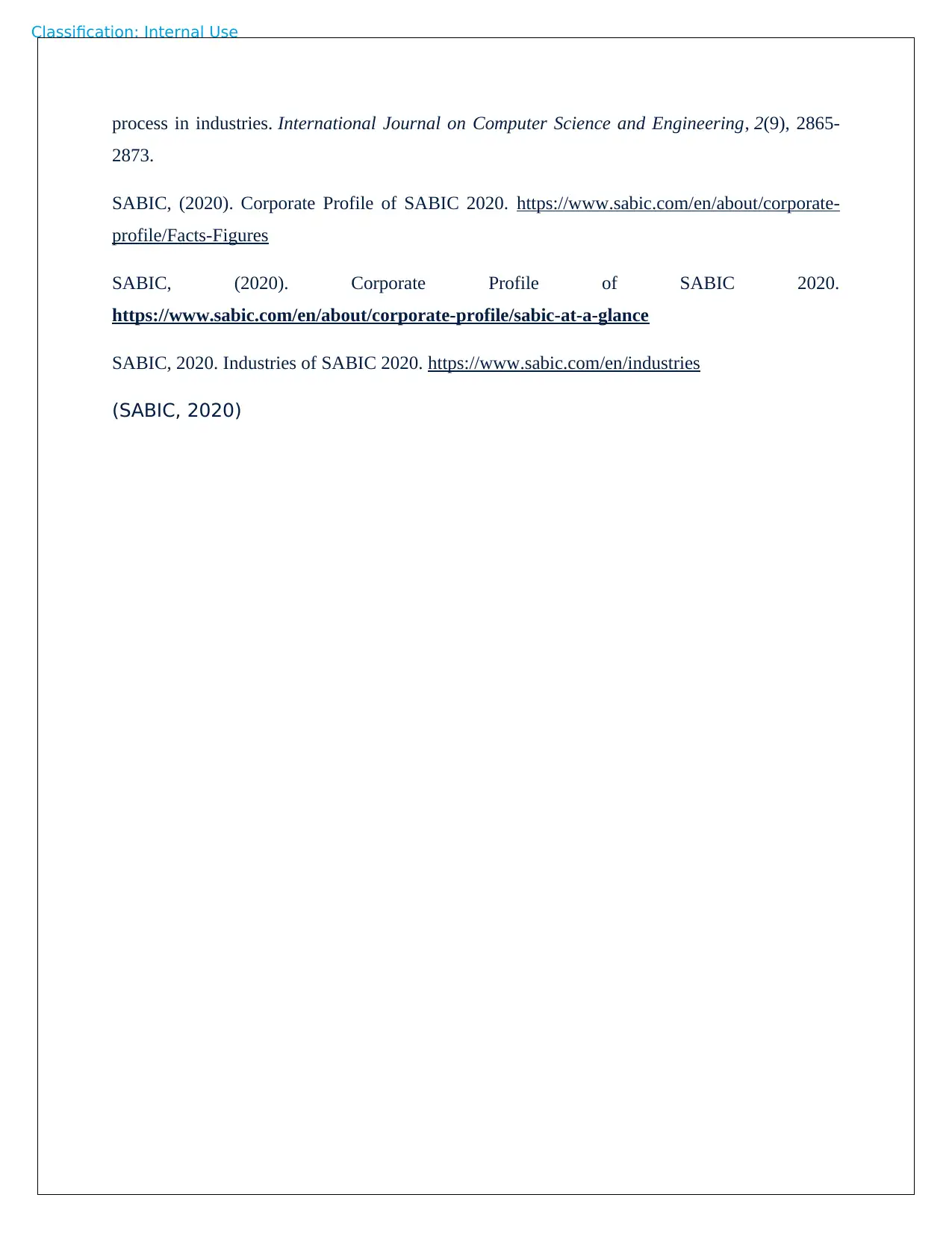
Classification: Internal Use
process in industries. International Journal on Computer Science and Engineering, 2(9), 2865-
2873.
SABIC, (2020). Corporate Profile of SABIC 2020. https://www.sabic.com/en/about/corporate-
profile/Facts-Figures
SABIC, (2020). Corporate Profile of SABIC 2020.
https://www.sabic.com/en/about/corporate-profile/sabic-at-a-glance
SABIC, 2020. Industries of SABIC 2020. https://www.sabic.com/en/industries
(SABIC, 2020)
process in industries. International Journal on Computer Science and Engineering, 2(9), 2865-
2873.
SABIC, (2020). Corporate Profile of SABIC 2020. https://www.sabic.com/en/about/corporate-
profile/Facts-Figures
SABIC, (2020). Corporate Profile of SABIC 2020.
https://www.sabic.com/en/about/corporate-profile/sabic-at-a-glance
SABIC, 2020. Industries of SABIC 2020. https://www.sabic.com/en/industries
(SABIC, 2020)
1 out of 13
Related Documents
Your All-in-One AI-Powered Toolkit for Academic Success.
+13062052269
info@desklib.com
Available 24*7 on WhatsApp / Email
![[object Object]](/_next/static/media/star-bottom.7253800d.svg)
Unlock your academic potential
© 2024 | Zucol Services PVT LTD | All rights reserved.





